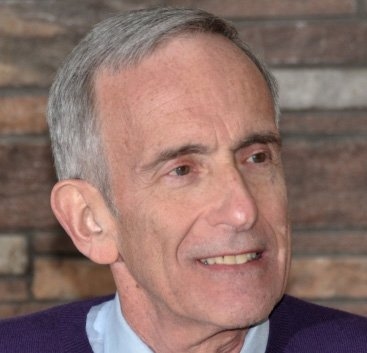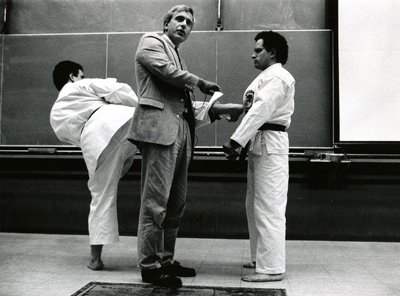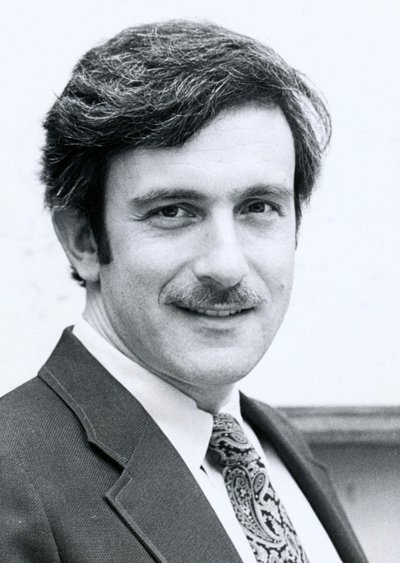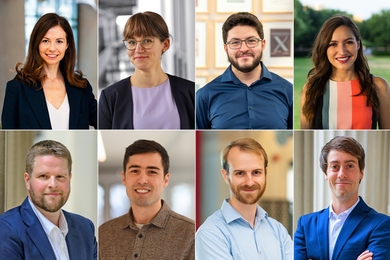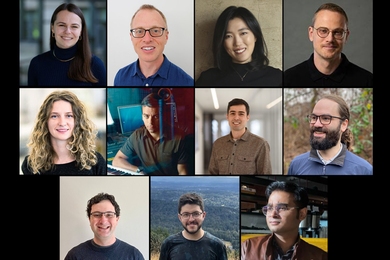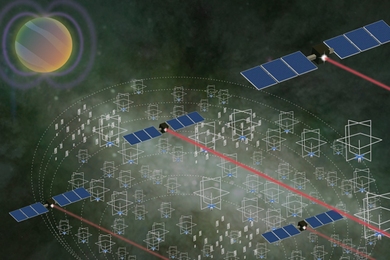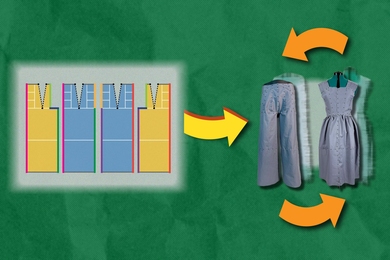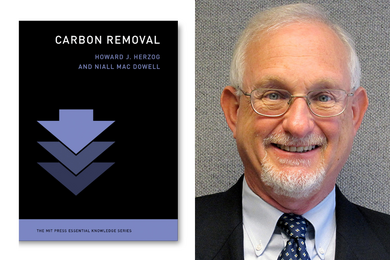MIT Professor of Physics Michael S. Feld, who made fundamental contributions in the field of laser science and later applied physics to solving biomedical problems, died on Saturday, April 10, after an eight-year struggle with multiple myeloma. Feld, who directed the MIT George R. Harrison Spectroscopy Laboratory since 1976, was 69.
Feld first came to MIT in 1958 as an undergraduate. He went on to do his PhD at MIT under the supervision of Professor Ali Javan, and in 1968 he became a member of the MIT faculty. During his 52 years at MIT he was an active contributor to the Institute community; he was particularly proud of his work helping to develop a welcoming ambience for minority students, staff and faculty.
“He had an amazing track record of mentoring African-American scientists, including astronaut Ronald McNair, who received his PhD under Michael’s supervision. In turn, Ron became Michael’s karate master. Michael delighted in illustrating the physics of karate with classroom demonstrations like breaking a wooden board with a swift blow. And when Michael stopped advancing at the brown belt, he encouraged his sons to persist to obtain black belts, showing that the true master is the one who helps others to achieve their best,” said Edmund Bertschinger, head of MIT’s Department of Physics.
Feld's research interests ranged from fundamental physics — superradiance and innovations in laser spectroscopy — to biomedicine and biomedical engineering, new kinds of microscopy, spectroscopic identification of cancer cells, and novel uses of the electric field to study cell behavior. In 1973, Feld made the first experimental observation of superradiance, the collective spontaneous emission of an assembly of excited atoms. In 1987, he began a series of experiments to study the radiation of a single, isolated atom in an optical resonator, which led to the first demonstration of enhanced and suppressed spontaneous emission and radiative level shifts in an open optical resonator and, in 1994, to the development of the single atom laser.
Feld's more recent research activities dealt with laser biomedicine. He directed the Laser Biomedical Research Center at MIT, where he worked on the use of fluorescence and Raman spectroscopy to diagnose biological tissues and image disease via endoscopy and optical tomography.
Feld was a hard worker who inspired his students to follow his example, said Ramachandra Dasari, associate director of the Spectroscopy Lab, who has been a friend and colleague of Feld’s since 1980. At the time, Feld was trying to persuade Dasari to leave a job in India to come to MIT, which he was reluctant to do. “I told him to give me a 10-month appointment and then I would go back,” Dasari said. But Feld’s friendship and willingness to let Dasari work on whatever he liked convinced him to stay. “Both professionally and personally my life has been intertwined with Michael’s for so many years we have become members of each other’s families,” said Dasari.
Feld supervised more than 50 PhD students during his career, and even in the past few months, as he was in and out of the hospital, he continued coming into the lab and working with his graduate students.
He also enjoyed singing and started a group called the Spectratones, which performed at Spectroscopy Lab events. Many of the group’s songs were based on poems that Feld composed about his students and colleagues, said Dasari. Last summer, the Spectratones performed at “Feld Fest,” a symposium held to honor Feld’s 50 years at MIT and 33 years as director of the Spectroscopy Lab.
Feld received the Thompson Award in 1991 for the development of biomedical Raman spectroscopy, and the Vinci of Excellence (France) in 1995 for development of the single atom laser. In 1992, he was the Wolk Visitor and Lecturer at Colgate University. He was 1996 Distinguished Baetjer Colloquium speaker at Princeton University. He was a research member of the joint faculty of the Harvard-MIT Division of Health, Science and Technology, and an adjunct staff member in the Department of Cardiovascular Research of the Cleveland Clinic Foundation. In 2003, he received the Lamb Medal of the Physics of Quantum Electronics Conference for the first experimental demonstrations of superradiance and the microlaser and for pioneering applications of optics to biological physics. In 2008, the Optical Society of America gave him its prestigious William F. Meggers Award in recognition of his major contributions to the foundations of laser spectroscopy and his pioneering developments in the application of spectroscopy to biomedicine.
He is survived by his wife, Alison Hearn, and his three children, Alexandra, Jonathan and David.
A funeral service will be held at 11 a.m. on Monday, April 12, at the Levine Funeral Chapel, 470 Harvard St in Brookline, Mass. Interment will be on Tuesday, April 13, in the family plot in Wellwood Cemetery, Pinelawn, N.Y. (Long Island). There will be a memorial service at MIT later this spring.
A memorial service will be held at 12:00 p.m. on Wednesday, June 16, in the MIT Chapel.
Feld first came to MIT in 1958 as an undergraduate. He went on to do his PhD at MIT under the supervision of Professor Ali Javan, and in 1968 he became a member of the MIT faculty. During his 52 years at MIT he was an active contributor to the Institute community; he was particularly proud of his work helping to develop a welcoming ambience for minority students, staff and faculty.
“He had an amazing track record of mentoring African-American scientists, including astronaut Ronald McNair, who received his PhD under Michael’s supervision. In turn, Ron became Michael’s karate master. Michael delighted in illustrating the physics of karate with classroom demonstrations like breaking a wooden board with a swift blow. And when Michael stopped advancing at the brown belt, he encouraged his sons to persist to obtain black belts, showing that the true master is the one who helps others to achieve their best,” said Edmund Bertschinger, head of MIT’s Department of Physics.
Feld's research interests ranged from fundamental physics — superradiance and innovations in laser spectroscopy — to biomedicine and biomedical engineering, new kinds of microscopy, spectroscopic identification of cancer cells, and novel uses of the electric field to study cell behavior. In 1973, Feld made the first experimental observation of superradiance, the collective spontaneous emission of an assembly of excited atoms. In 1987, he began a series of experiments to study the radiation of a single, isolated atom in an optical resonator, which led to the first demonstration of enhanced and suppressed spontaneous emission and radiative level shifts in an open optical resonator and, in 1994, to the development of the single atom laser.
Feld's more recent research activities dealt with laser biomedicine. He directed the Laser Biomedical Research Center at MIT, where he worked on the use of fluorescence and Raman spectroscopy to diagnose biological tissues and image disease via endoscopy and optical tomography.
Feld was a hard worker who inspired his students to follow his example, said Ramachandra Dasari, associate director of the Spectroscopy Lab, who has been a friend and colleague of Feld’s since 1980. At the time, Feld was trying to persuade Dasari to leave a job in India to come to MIT, which he was reluctant to do. “I told him to give me a 10-month appointment and then I would go back,” Dasari said. But Feld’s friendship and willingness to let Dasari work on whatever he liked convinced him to stay. “Both professionally and personally my life has been intertwined with Michael’s for so many years we have become members of each other’s families,” said Dasari.
Feld supervised more than 50 PhD students during his career, and even in the past few months, as he was in and out of the hospital, he continued coming into the lab and working with his graduate students.
He also enjoyed singing and started a group called the Spectratones, which performed at Spectroscopy Lab events. Many of the group’s songs were based on poems that Feld composed about his students and colleagues, said Dasari. Last summer, the Spectratones performed at “Feld Fest,” a symposium held to honor Feld’s 50 years at MIT and 33 years as director of the Spectroscopy Lab.
Feld received the Thompson Award in 1991 for the development of biomedical Raman spectroscopy, and the Vinci of Excellence (France) in 1995 for development of the single atom laser. In 1992, he was the Wolk Visitor and Lecturer at Colgate University. He was 1996 Distinguished Baetjer Colloquium speaker at Princeton University. He was a research member of the joint faculty of the Harvard-MIT Division of Health, Science and Technology, and an adjunct staff member in the Department of Cardiovascular Research of the Cleveland Clinic Foundation. In 2003, he received the Lamb Medal of the Physics of Quantum Electronics Conference for the first experimental demonstrations of superradiance and the microlaser and for pioneering applications of optics to biological physics. In 2008, the Optical Society of America gave him its prestigious William F. Meggers Award in recognition of his major contributions to the foundations of laser spectroscopy and his pioneering developments in the application of spectroscopy to biomedicine.
He is survived by his wife, Alison Hearn, and his three children, Alexandra, Jonathan and David.
A funeral service will be held at 11 a.m. on Monday, April 12, at the Levine Funeral Chapel, 470 Harvard St in Brookline, Mass. Interment will be on Tuesday, April 13, in the family plot in Wellwood Cemetery, Pinelawn, N.Y. (Long Island). There will be a memorial service at MIT later this spring.
A memorial service will be held at 12:00 p.m. on Wednesday, June 16, in the MIT Chapel.
